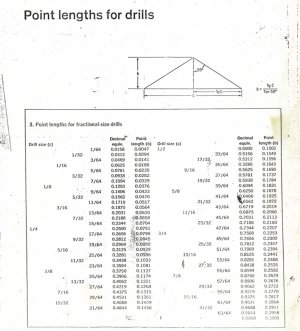I often find myself having to calculate drill tip lengths to make jobs with blind holes easier. Actually, after having to do it twice I whipped up an Excel sheet and made a chart that calculated the tip lengths for all number, letter and fractions drills up to one inch for both 118 and 135 degree varieties. I'm an engineer - I've been taught to do work upfront so I can be lazy later. I thought I would share it with all of you so you can be lazy too, with the added bonus of not having to do the work. The chart is attached and is in .pdf format. It is sized for legal paper, 8.5 x 14. If you have any inclination to use it, I suggest printing it out in color and laminating it. I keep a few spread out in the shop and one at my desk, and find them equally handy as just a drill chart.
Here is the chart -> View attachment 88217
This is a preview of what the chart looks like:
View attachment 88219
The math is simple trigonometry, and I thought the best way to show it was visually:
View attachment 88218
Define any drill by its diameter (D) and the included tip angle (A). The tip length (L) is given by a formula which can be written several ways. The most direct is using simple division, and is written as L = (D/2) / tan(A/2). If we were to write that out, it would be "the tip length is equal to half the drill diameter divided by the tangent of half of the tip angle". The formula can also be written using multiplication instead of division, and is shown in the diagram. It is L = (D/2) x tan(C), where C = 90 - (A/2).
For example, a #37, 118 degree drill. It has a diameter of 0.104 (D=0.104) and an angle of 118 degrees (A=118). So, the tip length is L = (0.104/2) / tan(118/2) = 0.052 / tan(59) = 0.052 / 1.6643 =
0.031.
Another example, a 13/32", 135 degree drill. It has a diameter of 0.406 (D=0.406) and an angle of 135 degrees (A=135). I'll do this one using the other form of the formula. So, tip length is L = (0.406/2) x tan(90 - (135/2)) = .203 x tan(90 - 67.5) = .203 x tan(22.5) = .203 x .4142 =
0.084.
I hope others can find this useful. Enjoy.
View attachment 88218 View attachment 88219


